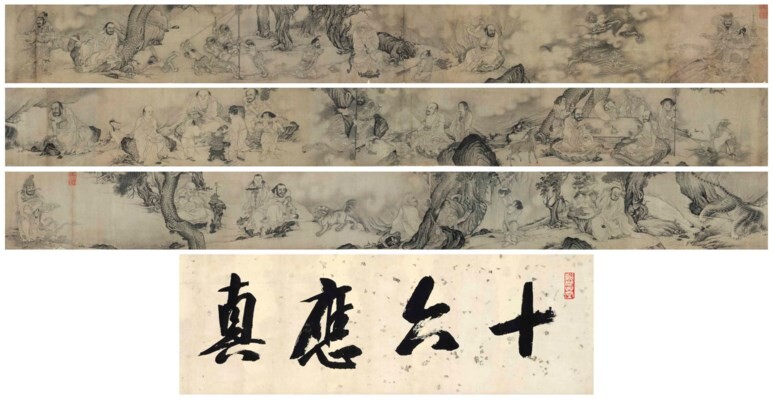ANONYMOUS (13TH-14TH CENTURY), Sixteen Arhats
ANONYMOUS (13TH-14TH CENTURY)
Sixteen Arhats
Handscroll, ink on paper
12 3/8 x 352 in. (31.5 x 894 cm.)
Two collector’s seals of Zhao Mengfu (1254-1322)
Frontispiece by Wang Jiqian (C. C. Wang, 1907-2003), signed with two seals and dated early summer, xinwei year (1991)
Three detached colophons: one by Yong Kai Chiu (20th century) and Tsang Kao Mun (20th century), signed and dated early summer, 1970; one by Li Yuanmao (born 1944) and Wu Jialin (born 1927), signed and dated 4 April 2009
Provenance
Lot 948, 30 May 2005, Fine Classical Chinese Paintings and Calligraphy, Christie’s Hong Kong.
Pre-Lot Text
Executed by an anonymous painter employing ink and line drawing technique, Sixteen Arhats illustrates the lives and preaching scenes of the sixteen lohans, the preservers of the teaching of Buddhism. In a well-plotted composition, each lohan and every element on the scroll was meticulously and vividly rendered in very fine and vigorous brushstrokes, which resulted in powerful and striking images. This handscroll has been generally regarded as a rare and important work by a great master of the Yuan dynasty or earlier. Some connoisseurs have even attributed it to the Song painter, Li Gonglin (1049-1106).
Sixteen Arhats has two collector’s seals of the Yuan master Zhao Mengfu (1254-1322). According to the Qing literature Pei Wen Zhai Shuhua Pu (Paintings and Calligraphy Register of Pei Wen Studio) compiled by Wang Yuanqi et al., there was a handscroll of Sixteen Arhats by Li Longmian (Li Gonglin) in the collection of Erya studio of Wang Shizhen of the Ming period. As stated in the detached colophons accompanying this painting, it was kept in Guangji Temple in Beijing for centuries until the early 20th century, when it came into the possession of the warlord Duan Qirui (1865-1936). Duan gifted this painting to his grand-daughter Duan Mei, wife of Dr. Tsang Chiu Tak (1900-1981), who migrated to Hong Kong in the 1940s. She then passed it to her brother-in-law, Dr. Tsang Chiu Sam(1901-?), who organized an exhibition with this painting at the Hong Kong City Hall.
In 1974, Sixteen Arhats was exhibited at Frank Caro Gallery in New York and was published in the May 1974 issue of Ming Pao Monthly in Hong Kong. In 1991 Wang Jiqian (C. C. Wang, 1907-2003) inscribed and signed the frontispiece of this handscroll. It was speculated that the anonymous colophon accompanying this work was also executed by Wang.
Sixteen Arhats has been a dear treasure of the current owner since 2005. It was featured in Guobao Dangan (File on National Treasures), an annual television program broadcasted by CCTV of China, on 8 and 9 November 2007.
Literature
Ming Pao Monthly Vol.9 No.5, Hong Kong Ming Pao Company Limited, Hong Kong, May 1974, pp.56-60.
Exhibited
Frank Caro Gallery, New York, 1974.
Hong Kong City Hall, Hong Kong, date unknown.
View it on
Sale price
Estimate
Time, Location
Auction House
ANONYMOUS (13TH-14TH CENTURY)
Sixteen Arhats
Handscroll, ink on paper
12 3/8 x 352 in. (31.5 x 894 cm.)
Two collector’s seals of Zhao Mengfu (1254-1322)
Frontispiece by Wang Jiqian (C. C. Wang, 1907-2003), signed with two seals and dated early summer, xinwei year (1991)
Three detached colophons: one by Yong Kai Chiu (20th century) and Tsang Kao Mun (20th century), signed and dated early summer, 1970; one by Li Yuanmao (born 1944) and Wu Jialin (born 1927), signed and dated 4 April 2009
Provenance
Lot 948, 30 May 2005, Fine Classical Chinese Paintings and Calligraphy, Christie’s Hong Kong.
Pre-Lot Text
Executed by an anonymous painter employing ink and line drawing technique, Sixteen Arhats illustrates the lives and preaching scenes of the sixteen lohans, the preservers of the teaching of Buddhism. In a well-plotted composition, each lohan and every element on the scroll was meticulously and vividly rendered in very fine and vigorous brushstrokes, which resulted in powerful and striking images. This handscroll has been generally regarded as a rare and important work by a great master of the Yuan dynasty or earlier. Some connoisseurs have even attributed it to the Song painter, Li Gonglin (1049-1106).
Sixteen Arhats has two collector’s seals of the Yuan master Zhao Mengfu (1254-1322). According to the Qing literature Pei Wen Zhai Shuhua Pu (Paintings and Calligraphy Register of Pei Wen Studio) compiled by Wang Yuanqi et al., there was a handscroll of Sixteen Arhats by Li Longmian (Li Gonglin) in the collection of Erya studio of Wang Shizhen of the Ming period. As stated in the detached colophons accompanying this painting, it was kept in Guangji Temple in Beijing for centuries until the early 20th century, when it came into the possession of the warlord Duan Qirui (1865-1936). Duan gifted this painting to his grand-daughter Duan Mei, wife of Dr. Tsang Chiu Tak (1900-1981), who migrated to Hong Kong in the 1940s. She then passed it to her brother-in-law, Dr. Tsang Chiu Sam(1901-?), who organized an exhibition with this painting at the Hong Kong City Hall.
In 1974, Sixteen Arhats was exhibited at Frank Caro Gallery in New York and was published in the May 1974 issue of Ming Pao Monthly in Hong Kong. In 1991 Wang Jiqian (C. C. Wang, 1907-2003) inscribed and signed the frontispiece of this handscroll. It was speculated that the anonymous colophon accompanying this work was also executed by Wang.
Sixteen Arhats has been a dear treasure of the current owner since 2005. It was featured in Guobao Dangan (File on National Treasures), an annual television program broadcasted by CCTV of China, on 8 and 9 November 2007.
Literature
Ming Pao Monthly Vol.9 No.5, Hong Kong Ming Pao Company Limited, Hong Kong, May 1974, pp.56-60.
Exhibited
Frank Caro Gallery, New York, 1974.
Hong Kong City Hall, Hong Kong, date unknown.



